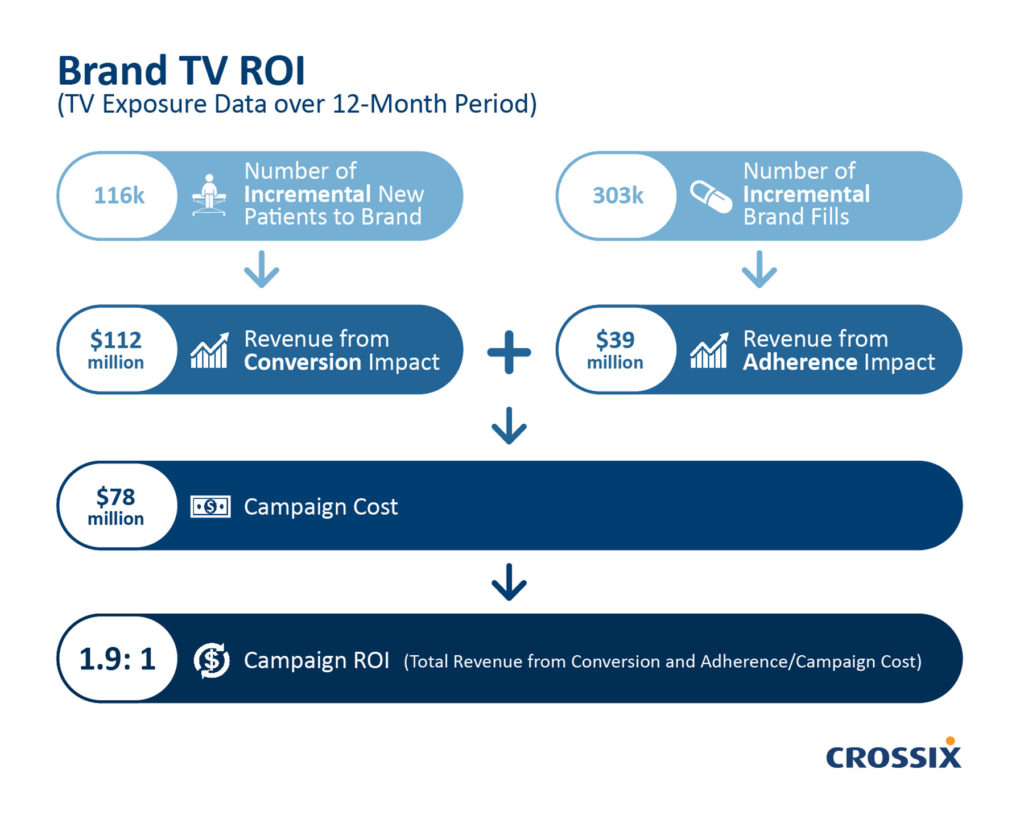Pharma companies can all acknowledge the importance of driving better patient adherence to improve health outcomes and lower healthcare costs. According to McKinsey research, an estimated 50% to 60% of patients with chronic illnesses miss doses, take the wrong doses or drop off treatment in the first year—resulting in additional healthcare expenditures of $290 billion driven by nonadherence.1
However, pharma marketing campaigns are traditionally only focused on the beginning of the patient journey—starting new users on the brand. To truly understand the value of the marketing investment, marketers should consider both the conversion and adherence benefits.
When consumers see ads for drug brands they are already prescribed, the ads can not only serve as a reminder to take the medicine, it can also serve as a reminder to refill their prescriptions. For patients, compliance and adherence to prescribed treatment plans can be influential in achieving the desired health outcomes, as well as lessen health expenditures driven by nonadherence. For brands, it can also have a significant impact on revenue.
So, why is adherence often not considered when measuring DTC campaign impact?
Pharmaceutical marketers often find it difficult to look beyond conversion and take a holistic approach when determining all drivers of revenue for DTC campaigns. Adherence is typically not the primary goal of the campaign, and it is hard to measure the impact attributed to ad exposure with precision, so brands often don’t account for retention efforts when determining the effectiveness of campaigns. In order to properly quantify the adherence benefit, pharma marketers need to have the right data measurement and analytics in place to be able to gauge how effective their advertising is at causing a patient to convert and stay on brand.
The Right Data, Technology, and Methodology
To understand the full impact of marketing campaigns, brands need to be able to tie advertising to patient behavior and health outcomes. To do so, marketers must get a complete view of a brand’s campaign to evaluate audience quality and demonstrate the benefit driven by advertising exposure.
At Crossix, our privacy-safe technology allows us to connect actual health and media exposure data to precisely calculate the impact of marketing efforts. Our proprietary control picking methodology allows us to properly control for all relevant health and consumer variables to isolate the impact of marketing campaigns. Then, using advanced analytics, we calculate conversion to brand and adherence rates between the treatment and control audiences to determine the respective lift attributed to campaign exposure.
Case Study: Quantifying the True Adherence Impact of TV
For example, we recently analyzed a brand’s national television campaign to determine the full ROI of both conversion and adherence. We first were able to determine how effective the TV campaign was at driving incremental new patients to brand.
The overall unique audience exposed to the campaign converted to the brand at a 1.7X lift above those who did not see the campaign, resulting in 116k incremental new patient starts. With a campaign investment of $78MM, the net conversion generated a 1.4:1 ROI.
We then examined the incremental adherence impact generated by the TV campaign. To do so, we measured cumulative prescription fills among existing brand patients exposed to TV over a 12-month period. We found that through 12 months, patients who saw the TV campaign had 0.3 incremental fills per person—an increase of 303k brand refills overall. These findings indicate that TV messaging is an effective refill reminder.
When measuring the impact of the brand’s TV campaign with the inclusion of adherence data, we found campaign ROI increased from 1.4:1 to 1.9:1 (see Figure 1). The brand recognized the importance of evaluating both new brand patient starts and incremental brand refills to determine the full value of their TV campaign.
 By getting a more holistic view of the impact of DTC campaigns accounting for the conversion and adherence impact, you can more precisely inform future marketing investment decisions.
By getting a more holistic view of the impact of DTC campaigns accounting for the conversion and adherence impact, you can more precisely inform future marketing investment decisions.
References:
1.“Improving Patient Adherence Through Data-driven Insights.” McKinsey & Company, December 2018. https://www.mckinsey.com/industries/pharmaceuticals-and-medical-products/our-insights/improving-patient-adherence-through-data-driven-insights.








